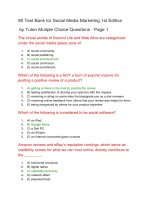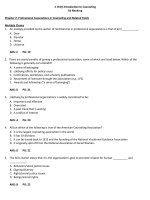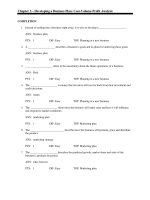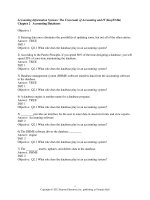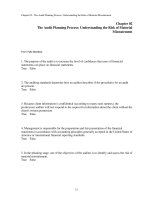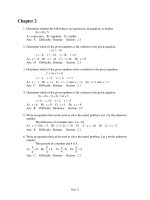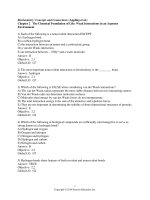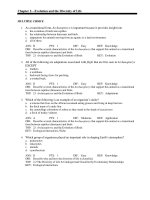Social media marketing 1st edition tuten test bank
Bạn đang xem bản rút gọn của tài liệu. Xem và tải ngay bản đầy đủ của tài liệu tại đây (116.57 KB, 32 trang )
Social Media Marketing (Tuten)
Chapter 2 Strategic Planning with Social Media
2.1 Multiple Choice
1) Which of the following terms describes the process of identifying objectives to accomplish, deciding
how to accomplish those objectives with specific strategies and tactics, implementing the actions that
make the plan come to life, and measuring how well the plan met the objectives?
A) concepting
B) strategic planning
C) ideation
D) briefing
E) positioning
Answer: B
Explanation: B) The process of strategic planning is three-tiered, beginning at the corporate level, then
moving to the business level and lastly, moving to the functional areas of the organization, including
marketing.
Page Ref: 2-2
Difficulty: Moderate
Learning Obj.: 1
Classification: Conceptual
2) The three tiers of strategic planning, in order from beginning to end, are:
A) product level, promotion level, and distribution areas.
B) business level, functional areas, and corporate level.
C) promotion level, distribution areas, and product level.
D) corporate level, business level, and functional areas.
E) distribution areas, product level, and promotion level.
Answer: D
Explanation: D) Planners first identify their overall objectives (e.g., "raise consumer awareness of our
brand by 10 percent in the next year") and then develop the specific tactics they will use to reach those
goals (e.g., "increase our spending on print advertising in targeted publications by 15 percent this year").
Page Ref: 2-2
Difficulty: Moderate
Learning Obj.: 1
Classification: Conceptual
1
Copyright © 2013 Pearson Education, Inc. publishing as Prentice Hall
3) A(n) ________ is a written, formalized plan that details the product, pricing, distribution, and
promotional strategies that will enable the brand in question to accomplish specific marketing
objectives.
A) strategic plan
B) creative message strategy
C) marketing plan
D) integrated marketing communications plan
E) positioning statement
Answer: C
Explanation: C) There is tremendous value in planning. Dumb luck and sweat takes you only so far.
Planning ensures that an organization understands its markets and its competitors. It helps to ensure that
organizations are aware of the changing marketplace environment.
Page Ref: 2-3
Difficulty: Moderate
Learning Obj.: 1
Classification: Conceptual
4) Which of the following represents a consequence of planning?
A) An organization comes to understand its markets and its competitors.
B) An organization becomes aware of the changing marketplace environment.
C) Managers gain the ability to allocate limited resources using established priorities.
D) Success becomes defined and measured.
E) All of the above
Answer: E
Explanation: E) What's wrong with jumping right into the game? Why should we take the time to plan?
Although it's tempting to just follow our instincts, it turns out there is tremendous value in planning.
Dumb luck and sweat takes you only so far.
Page Ref: 2-3
Difficulty: Easy
Learning Obj.: 1
Classification: Conceptual
5) A(n) ________ provides in-depth detail on the execution of the (traditional) promotional portion of a
brand's marketing plan.
A) strategic plan
B) creative message strategy
C) marketing plan
D) integrated marketing communications plan
E) positioning statement
Answer: D
Explanation: D) An approach for developing an in-depth social media marketing strategy
Page Ref: 2-4
Difficulty: Moderate
Learning Obj.: 1
Classification: Conceptual
2
Copyright © 2013 Pearson Education, Inc. publishing as Prentice Hall
6) Which of the following represents a consequence of social media marketing maturity?
A) Social media marketing activities are consistent with their marketing and marketing communications
plans.
B) Social media marketing activities are capable of meeting specific marketing objectives.
C) Social media applications that start as one-time "experiments" often morph into more long-term and
carefully thought-out communications pieces.
D) Social media promotions become integrated with the overall promotional campaigns in place to reach
customers.
E) All of the above
Answer: E
Explanation: E) Although it seems everyone is talking about social media, it's one thing to claim you
use social media and quite another to say you have a strategy that incorporates social media. Many
marketers currently use social media marketing tactics without that level of maturity
Page Ref: 2-5
Difficulty: Easy
Learning Obj.: 2
AACSB Category: Communication Abilities
Classification: Conceptual
7) Which one of the following statements is TRUE?
A) Most marketers currently use social media marketing tactics with a high level of maturity.
B) Most marketers currently use social media marketing tactics on a strategic level.
C) There are very few marketers that use social media marketing tactics in the trial phase.
D) There are many marketers that use social media marketing tactics in the trial phase.
E) There are very few marketers that use social marketing tactics in the first phase of the adoption cycle.
Answer: D
Explanation: D) A major study of marketers in both Europe and North America found huge differences
in the level to which respondents use social media and integrate it with their other initiatives. Many still
just experiment with baby steps (like creating a Facebook page) rather than include social media as a
fundamental component of their marketing strategy.
Page Ref: 2-6
Difficulty: Moderate
Learning Obj.: 2
Classification: Critical Thinking
8) Which one of the following statements is TRUE?
A) Most marketers currently use social media marketing tactics with a high level of maturity.
B) Most marketers currently use social media marketing tactics on a strategic level.
C) There are very few marketers that use social media marketing tactics in the trial phase.
D) There are very few marketers that use social marketing tactics in the first phase of the adoption cycle.
E) There are many marketers that use social marketing tactics in the first phase of the adoption cycle.
Answer: E
Explanation: E) A major study of marketers in both Europe and North America found huge differences
in the level to which respondents use social media and integrate it with their other initiatives. Many still
just experiment with baby steps (like creating a Facebook page) rather than include social media as a
fundamental component of their marketing strategy.
Page Ref: 2-6
Difficulty: Moderate
Learning Obj.: 2
Classification: Critical Thinking
3
Copyright © 2013 Pearson Education, Inc. publishing as Prentice Hall
9) Which one of the following statements is FALSE?
A) Most marketers have not yet integrated social media as a key component of the overall marketing
plan.
B) Most marketers currently use social media marketing tactics on a strategic level.
C) There are many marketers that use social media marketing tactics without a high level of maturity.
D) There are many marketers that use social media marketing tactics in the trial phase.
E) There are many marketers that use social marketing tactics in the first phase of the adoption cycle.
Answer: B
Explanation: B) A major study of marketers in both Europe and North America found huge differences
in the level to which respondents use social media and integrate it with their other initiatives. Many still
just experiment with baby steps (like creating a Facebook page) rather than include social media as a
fundamental component of their marketing strategy.
Page Ref: 2-6
Difficulty: Moderate
Learning Obj.: 2
Classification: Critical Thinking
10) Which of the following depicts an organization in the trial phase of the social media marketing
maturity life cycle?
A) experimenting with cool new social media ways to communicate
B) planning social media marketing activities with clear objectives and metrics
C) integrating social media as a key component of the organization's overall marketing plan
D) thinking about social media activities in a more systematic way
E) None of the above
Answer: A
Explanation: A) In these early days of adopting social media, most groups focus on learning to use a
new form of communication and exploring the potential for social media as a venue.
Page Ref: 2-6
Difficulty: Moderate
Learning Obj.: 2
AACSB Category: Communication Abilities
Classification: Conceptual
4
Copyright © 2013 Pearson Education, Inc. publishing as Prentice Hall
11) Which of the following depicts an organization in the transition phase of the social media marketing
maturity life cycle?
A) experimenting with cool new social media ways to communicate
B) planning social media marketing activities with clear objectives and metrics
C) integrating social media as a key component of the organization's overall marketing plan
D) thinking about social media activities in a more systematic way
E) None of the above
Answer: D
Explanation: D) Marketing research firm Marketing Sherpa found in its 2010 Social Media Marketing
Benchmarking Report that 40 percent of the organizations included in the study reported that their social
media activities resided in the transition phase. Thirty-three percent acknowledged they were
experimenting in the trial phase, and 23 percent were advancing, learning and adapting towards the
strategic phase.
Page Ref: 2-6
Difficulty: Moderate
Learning Obj.: 2
AACSB Category: Communication Abilities
Classification: Conceptual
12) Which of the following depicts an organization in the strategic phase of the social media marketing
maturity life cycle?
A) experimenting with cool new social media ways to communicate
B) exploring the potential for social media as a venue
C) integrating social media as a key component of the organization's overall marketing plan
D) thinking about social media activities in a more systematic way
E) None of the above
Answer: C
Explanation: C) Marketing research firm Marketing Sherpa found in its 2010 Social Media Marketing
Benchmarking Report that 40 percent of the organizations included in the study reported that their social
media activities resided in the transition phase. Thirty-three percent acknowledged they were
experimenting in the trial phase, and 23 percent were advancing, learning and adapting towards the
strategic phase.
Page Ref: 2-6
Difficulty: Moderate
Learning Obj.: 2
AACSB Category: Communication Abilities
Classification: Conceptual
5
Copyright © 2013 Pearson Education, Inc. publishing as Prentice Hall
13) Which of the following depicts an organization in the strategic phase of the social media marketing
maturity life cycle?
A) experimenting with cool new social media ways to communicate
B) exploring the potential for social media as a venue
C) planning social media marketing activities with clear objectives and metrics
D) thinking about social media activities in a more systematic way
E) None of the above
Answer: C
Explanation: C) Marketing research firm Marketing Sherpa found in its 2010 Social Media Marketing
Benchmarking Report that 40 percent of the organizations included in the study reported that their social
media activities resided in the transition phase. Thirty-three percent acknowledged they were
experimenting in the trial phase, and 23 percent were advancing, learning and adapting towards the
strategic phase.
Page Ref: 2-6
Difficulty: Moderate
Learning Obj.: 2
AACSB Category: Communication Abilities
Classification: Conceptual
14) A situation analysis is done in the ________ step of the social media marketing strategic planning
process.
A) first
B) second
C) third
D) fourth
E) last
Answer: A
Explanation: A) The first step in developing the plan is much the same as it is in the creation of
traditional strategic plans research and assess the environment. Good social media planning starts with
research on the industry and competitors, the product category, and the consumer market. This leads to a
situation analysis.
Page Ref: 2-10
Difficulty: Moderate
Learning Obj.: 3
Classification: Conceptual
6
Copyright © 2013 Pearson Education, Inc. publishing as Prentice Hall
15) Which of the following is done in the first step of the social media marketing strategic planning
process?
A) positioning statement
B) social media mix
C) social media profile
D) situation analysis
E) message strategy
Answer: D
Explanation: D) The first step in developing the plan is much the same as it is in the creation of
traditional strategic plans research and assess the environment. Good social media planning starts with
research on the industry and competitors, the product category, and the consumer market. This leads to a
situation analysis.
Page Ref: 2-10
Difficulty: Moderate
Learning Obj.: 3
Classification: Conceptual
16) The ________ details the current problem or opportunity the organization faces.
A) positioning statement
B) social media mix
C) social media profile
D) situation analysis
E) message strategy
Answer: D
Explanation: D) The first step in developing the plan is much the same as it is in the creation of
traditional strategic plans research and assess the environment. Good social media planning starts with
research on the industry and competitors, the product category, and the consumer market. This leads to a
situation analysis.
Page Ref: 2-10
Difficulty: Moderate
Learning Obj.: 3
Classification: Conceptual
17) A(n) ________ highlights relevant aspects of the firm's internal and external environment that could
affect the organization's choices, capabilities, and resources.
A) SWOT analysis
B) activation tool
C) objective and task method
D) stunt
E) propagation brief
Answer: A
Explanation: A) This acronym refers to strengths, weaknesses, opportunities, and threats that the firm
should consider as it crafts a strategy.
Page Ref: 2-10
Difficulty: Moderate
Learning Obj.: 3
Classification: Conceptual
7
Copyright © 2013 Pearson Education, Inc. publishing as Prentice Hall
18) A SWOT analysis is often included in the ________.
A) positioning statement
B) social media mix
C) social media profile
D) situation analysis
E) message strategy
Answer: D
Explanation: D) This acronym refers to strengths, weaknesses, opportunities, and threats that the firm
should consider as it crafts a strategy.
Page Ref: 2-10
Difficulty: Moderate
Learning Obj.: 3
Classification: Conceptual
19) The "S" in a SWOT analysis stands for:
A) social.
B) strengths.
C) strategic.
D) stunts.
E) shares.
Answer: B
Explanation: B) The firm should consider a SWOT analysis as it crafts a strategy.
Page Ref: 2-10
Difficulty: Easy
Learning Obj.: 3
Classification: Conceptual
20) The "W" in a SWOT analysis stands for:
A) windows.
B) weeks.
C) words.
D) women.
E) weaknesses.
Answer: E
Explanation: E) The firm should consider a SWOT analysis as it crafts a strategy.
Page Ref: 2-10
Difficulty: Easy
Learning Obj.: 3
Classification: Conceptual
8
Copyright © 2013 Pearson Education, Inc. publishing as Prentice Hall
21) The "O" in a SWOT analysis stands for:
A) outlooks.
B) operations.
C) opportunities.
D) objectives.
E) occasions.
Answer: C
Explanation: C) The firm should consider a SWOT analysis as it crafts a strategy.
Page Ref: 2-10
Difficulty: Easy
Learning Obj.: 3
Classification: Conceptual
22) The "T" in a SWOT analysis stands for:
A) time line.
B) targets.
C) traffic.
D) threats.
E) tools.
Answer: B
Explanation: B) The firm should consider a SWOT analysis as it crafts a strategy.
Page Ref: 2-10
Difficulty: Easy
Learning Obj.: 3
Classification: Conceptual
23) The controllable elements that influence how well the firm operates reside in the:
A) external environment only.
B) internal environment only.
C) both the external and internal environments.
D) neither the external nor internal environments.
E) mind of the consumer.
Answer: B
Explanation: B) The internal environment refers to the strengths and weaknesses of the organization.
Page Ref: 2-10
Difficulty: Moderate
Learning Obj.: 3
Classification: Conceptual
9
Copyright © 2013 Pearson Education, Inc. publishing as Prentice Hall
24) The uncontrollable elements that influence how well the firm operates reside in the:
A) external environment only.
B) internal environment only.
C) both the external and internal environments.
D) neither the external nor internal environments.
E) mind of the consumer.
Answer: A
Explanation: A) The external environment refers to the organization's opportunities and threats.
Page Ref: 2-10
Difficulty: Moderate
Learning Obj.: 3
Classification: Conceptual
25) An organization's strengths and weaknesses come from:
A) the external environment only.
B) the internal environment only.
C) both the external and internal environments.
D) neither the external nor internal environments.
E) the mind of the consumer.
Answer: B
Explanation: B) The internal environment refers to the controllable elements inside a firm that influence
how well the firm operates.
Page Ref: 2-10
Difficulty: Moderate
Learning Obj.: 3
Classification: Conceptual
26) An organization's opportunities and threats come from:
A) the external environment only.
B) the internal environment only.
C) both the external and internal environments.
D) neither the external nor internal environments.
E) the mind of the consumer.
Answer: A
Explanation: A) The external environment refers to the uncontrollable elements outside the organization
that influence how well the firm operates.
Page Ref: 2-10
Difficulty: Moderate
Learning Obj.: 3
Classification: Conceptual
10
Copyright © 2013 Pearson Education, Inc. publishing as Prentice Hall
27) Management in a firm can control:
A) its opportunities and threats.
B) its opportunities and strengths.
C) its strengths and weaknesses.
D) its strengths and threats.
E) its opportunities and weaknesses.
Answer: C
Explanation: C) The internal environment refers to the controllable elements inside a firm that influence
how well the firm operates.
Page Ref: 2-10
Difficulty: Moderate
Learning Obj.: 3
Classification: Conceptual
28) Management in a firm cannot control:
A) its opportunities and threats.
B) its opportunities and strengths.
C) its strengths and weaknesses.
D) its strengths and threats.
E) its opportunities and weaknesses.
Answer: A
Explanation: A) Management must respond to opportunities and threats through its planning process.
Page Ref: 2-10
Difficulty: Moderate
Learning Obj.: 3
Classification: Conceptual
29) Which of the following is a key aspect of a firm's external environment?
A) its mission statement
B) its social media marketing strategic plan
C) its stunts
D) its social media marketing maturity stage
E) its competition
Answer: E
Explanation: E) Analyzing competitive social media efforts and how the target market perceives those
efforts is a must-do in social media marketing planning.
Page Ref: 2-12
Difficulty: Difficult
Learning Obj.: 3
Classification: Synthesis
11
Copyright © 2013 Pearson Education, Inc. publishing as Prentice Hall
30) Which of the following questions should a competitive social media analysis answer?
A) In which social media channels and specific vehicles are competitors active?
B) How do competitors present themselves in those channels and vehicles?
C) Who are competitors' fans and followers?
D) How do fans and followers respond to the competitor brand's social activity?
E) All of the above
Answer: E
Explanation: E) You can use an internal system or a cloud service such as RivalMap
(www.rivalmap.com) to organize competitive information and monitor news and social activity. When
you use RivalMap, you can maintain a search of competitive activity and news mentions online for a
small fee.
Page Ref: 2-12
Difficulty: Easy
Learning Obj.: 3
Classification: Conceptual
31) A love mark:
A) is an exceedingly positive review on a social media site.
B) is a brand that commands passionate loyalty from its target market.
C) is the collection of positive word-of-mouth responses on a company's web page.
D) occurs after a brand collects 1000 "Likes" on its Facebook page.
E) is a special price promotion a company offers only its loyal customers.
Answer: B
Explanation: B) A study of design professionals showed that 80 percent would choose the brand
Benjamin Moore over any other brand of paint. And, a study of conversations in social media spaces
found that 95 percent of online conversations about Benjamin Moore were positive.
Page Ref: 2-14
Difficulty: Moderate
Learning Obj.: 3
Classification: Conceptual
32) ________ is the percentage of advertising for a brand compared to competing brands.
A) The competitive parity method
B) The objective and task method
C) Percentage of ad spend
D) Share of voice
E) Share of wallet
Answer: D
Explanation: D) A social media campaign has the potential to build a strong share of voice in social
media channels.
Page Ref: 2-14
Difficulty: Moderate
Learning Obj.: 3
Classification: Conceptual
12
Copyright © 2013 Pearson Education, Inc. publishing as Prentice Hall
33) The social media mix is composed of:
A) advertising, consumer promotion, personal selling, and public relations.
B) direct marketing, word-of-mouth promotion, telemarketing, and infomercials.
C) social communities, social publishing, social entertainment, and social commerce.
D) product, price, promotion, and place.
E) the traditional marketing mix plus the target market.
Answer: C
Explanation: C) Similar to a more traditional marketing mix, the social media mix describes the
combination of vehicles the strategy will include to attain the organization's objectives.
Page Ref: 2-22
Difficulty: Moderate
Learning Obj.: 3
Classification: Conceptual
34) A fund-raising campaign for a college sorority might be based on a ________ of a Facebook page, a
Twitter blast, and a Foursquare check-in competition at the local sorority house.
A) marketing mix
B) social media mix
C) SWOT analysis
D) stunt
E) creative brief
Answer: B
Explanation: B) The zones of social media make up the channel and vehicle choices available for a
social media mix. Similar to a more traditional marketing mix, the social media mix describes the
combination of vehicles the strategy will include to attain the organization's objectives.
Page Ref: 2-22
Difficulty: Moderate
Learning Obj.: 3
Classification: Application
35) Which of the following examples represents a social media mix choice?
A) The social networking media vehicles include Facebook, YouTube, and Flickr.
B) Social publishing utilizes a corporate blog.
C) The brand utilizes the existing social game, Retail Therapy.
D) Social publishing utilizes the document sharing site, Scribd.
E) All of the above
Answer: E
Explanation: E) The social media mix options lie among the four zones: relationship development in
social communities, social publishing, social entertainment, and social commerce. Within each zone are
many specific vehicles that may be best suited to reach a certain audience.
Page Ref: 2-22
Difficulty: Easy
Learning Obj.: 3
Classification: Application
13
Copyright © 2013 Pearson Education, Inc. publishing as Prentice Hall
36) ________ captures the heart of what the brand is and what the sponsor wants it to become.
A) Strategic plan
B) Creative message strategy
C) Marketing plan
D) Integrated marketing communications plan
E) Positioning statement
Answer: E
Explanation: E) The brand's positioning statement is a single written statement that encapsulates the
position the brand wishes to hold in the minds of its target audience.
Page Ref: 2-23
Difficulty: Moderate
Learning Obj.: 3
Classification: Conceptual
37) Which of the following best represents a positioning statement?
A) Google provides "the world's information in one click."
B) Apple seeks to make wide use of social games.
C) Sony's products are displayed clearly on their web site for customers to preview.
D) Microsoft constantly upgrades their products against viruses and potential bugs.
E) None of the above
Answer: A
Explanation: A) Positioning statements succinctly capture the heart of what the brand is and what the
sponsor wants it to become.
Page Ref: 2-23
Difficulty: Moderate
Learning Obj.: 3
Classification: Application
38) For social media marketing campaigns, planners create a(n) ________ to guide the development of
the campaign.
A) creative brief
B) experience brief
C) stunt
D) situation analysis
E) external environment
Answer: B
Explanation: B) Unlike traditional media, social media focus on interactive experiences, social sharing,
and engagement.
Page Ref: 2-23
Difficulty: Moderate
Learning Obj.: 3
Classification: Conceptual
14
Copyright © 2013 Pearson Education, Inc. publishing as Prentice Hall
39) A propagation brief is based on planning for:
A) a passive target audience.
B) the external environment.
C) the people you reach.
D) an organization's competitors.
E) the people that your target audience will reach.
Answer: E
Explanation: E) Traditional advertising promotes a message to a passive audience, and that audience is
the target. Social media invite an interactive experience with an audience of influencers who will then
share the brand's message and invite others to the experience.
Page Ref: 2-24
Difficulty: Difficult
Learning Obj.: 3
Classification: Conceptual
40) All of the following questions create answers that form the basis for a propagation brief EXCEPT:
A) Who is the target audience?
B) Is there another group of people who can persuade the target audience to follow them?
C) What content will be needed?
D) What are our competitors doing in terms of social marketing?
E) How will experience engagement be extended and shared throughout the social channels?
Answer: D
Explanation: D) To develop a social experience worthy of participation AND worthy of sharing, social
media planners ask and answer several of these types of questions.
Page Ref: 2-24
Difficulty: Easy
Learning Obj.: 3
Classification: Conceptual
41) ________ are the people who will propagate your message.
A) Followers
B) Influencers
C) Lurkers
D) Bloggers
E) Web crawlers
Answer: B
Explanation: B) To develop a social experience worthy of participation AND worthy of sharing, social
media planners attempt to identify influencers.
Page Ref: 2-25
Difficulty: Moderate
Learning Obj.: 3
AACSB Category: Analytic Skills
Classification: Conceptual
15
Copyright © 2013 Pearson Education, Inc. publishing as Prentice Hall
42) ________ drive a brand's paid and owned media, extend a brand's story, and foster social
experiences.
A) Activation tools
B) Hashtags
C) Creative assets
D) Social personas
E) Stunts
Answer: C
Explanation: C) To develop a social experience worthy of participation AND worthy of sharing, social
media planners attempt to identify existing creative assets.
Page Ref: 2-25
Difficulty: Moderate
Learning Obj.: 3
Classification: Conceptual
43) The GEICO gecko is a(n) ________ in that he gives the company a head start in terms of consumer
recognition as it tries to break through the clutter of competing messages.
A) activation tool
B) hashtag
C) creative asset
D) social persona
E) stunt
Answer: C
Explanation: C) To develop a social experience worthy of participation AND worthy of sharing, social
media planners attempt to identify existing creative assets.
Page Ref: 2-25
Difficulty: Moderate
Learning Obj.: 3
Classification: Application
44) ________ is the term used to describe the research stage of the plan.
A) Prototyping
B) Ideation
C) Discovery
D) Briefing
E) Concepting
Answer: C
Explanation: C) Planners may rely on secondary and primary research as they seek to discover insights
that will be useful to the creative team. These insights will be presented to the team during the briefing.
Page Ref: 2-26
Difficulty: Moderate
Learning Obj.: 3
Classification: Conceptual
16
Copyright © 2013 Pearson Education, Inc. publishing as Prentice Hall
45) Which of the following terms encompasses a brand's efforts to define how the brand will behave in
the social Web, what voice will be used, and how deeply the brand will interact in the social space with
customers?
A) social persona
B) ideation
C) share of voice
D) prototypes
E) concepting
Answer: A
Explanation: A) The decisions made should support the brand's position in the market. To introduce that
persona, brands have several creative options. They may involve humanizing the brand; showing a
vulnerability to the customer and working as a steward to customer service; or providing a value to the
customer whether that value be function, information, or entertainment.
Page Ref: 2-26
Difficulty: Difficult
Learning Obj.: 3
Classification: Conceptual
46) Benjamin Moore featured experts designers, architects, and contractors who all endorsed the
Benjamin Moore brand in their marketing campaign. These authority-based testimonials made up the
________.
A) share of voice
B) positioning statement
C) social persona
D) creative message strategy
E) stunts
Answer: D
Explanation: D) The creative message strategy refers to the creative approach used throughout a
campaign.
Page Ref: 2-28
Difficulty: Moderate
Learning Obj.: 3
Classification: Application
47) The final stage of the strategic planning process is to:
A) select the social media channels and vehicles.
B) state objectives.
C) create an experience strategy.
D) execute and measure the campaign.
E) gather insight into the target audience.
Answer: D
Explanation: D) The data gathered on all aspects of the social media plan are used to provide insight for
future campaigns.
Page Ref: 2-31
Difficulty: Moderate
Learning Obj.: 3
Classification: Conceptual
17
Copyright © 2013 Pearson Education, Inc. publishing as Prentice Hall
48) In which of the following stages of the social media marketing strategic planning process does the
planner elaborate on what is expected of the social media campaign and what financial and human
resources are available?
A) conduct a situation analysis
B) state objectives
C) create experience strategy
D) establish an activation plan
E) select the social media channels/vehicles
Answer: B
Explanation: B) An objective is a specific statement about a planned social media activity in terms of
what that activity intends to accomplish.
Page Ref: 2-15
Difficulty: Moderate
Learning Obj.: 4
Classification: Conceptual
49) A(n) ________ is a specific statement about a planned social media activity in terms of what that
activity intends to accomplish.
A) positioning statement
B) SWOT analysis
C) objective
D) experience brief
E) propagation brief
Answer: C
Explanation: C) The content of the objective will vary based on the situation and the problem at hand.
For instance, the campaign may be designed to amplify other marketing communication efforts the
organization uses.
Page Ref: 2-15
Difficulty: Moderate
Learning Obj.: 4
Classification: Conceptual
50) Which of the following characteristics is associated with an actionable objective?
A) be specific
B) be hopeful
C) specify the desired change
D) include a time line
E) be measurable
Answer: B
Explanation: B) It's important to state the objectives in a way that will help the planner to make other
decisions in the planning process and, eventually, to measure the extent to which the objective was
accomplished at specific points into the campaign.
Page Ref: 2-16
Difficulty: Easy
Learning Obj.: 4
Classification: Conceptual
18
Copyright © 2013 Pearson Education, Inc. publishing as Prentice Hall
51) Which of the following is the best example of an actionable objective?
A) To inspire happiness throughout the world by creating hope and wisdom on our company's Facebook
page.
B) To increase site awareness by 100 percent with the addition of social commerce sharing applications
by the third quarter of 2012.
C) To promote goodwill through positive word-of-mouth on our Twitter account in the not-so-distant
future
D) To increase our market share through effective advertising and promotions using the vast array of
social media technology.
E) To leapfrog our competition, jumping from last to first place in market share, in the next month by
blitzing our customers on social media sites.
Answer: B
Explanation: B) A well-stated, actionable objective should be specific, be measurable, specify the
desired change, include a time line, and be consistent and realistic.
Page Ref: 2-16
Difficulty: Moderate
Learning Obj.: 4
Classification: Application
52) Which of the following statements is TRUE?
A) Most organizations, to date, allocate a significant portion of their marketing budgets to social media.
B) Most companies plan to decrease monetary allocations to social media marketing activities.
C) Social media is not free.
D) Corporate resources do not need to be considered when setting marketing objectives.
E) Companies that are ambitious can and should set unrealistic marketing objectives.
Answer: C
Explanation: C) Granted, social media costs often are much lower compared to, say, a national
television campaign. But there are other costs associated with social media. Charlene Li, a leading social
media strategist, once said, "Social media trades media costs for labor costs."
Page Ref: 2-17
Difficulty: Difficult
Learning Obj.: 4
Classification: Synthesis
53) Which of the following statements is FALSE?
A) Most organizations, to date, allocate only a small portion of their marketing budgets to social media.
B) Most companies plan to increase monetary allocations to social media marketing activities.
C) Social media is free.
D) Corporate resources need to be considered when setting marketing objectives.
E) Even companies that are ambitious can and should set realistic marketing objectives.
Answer: C
Explanation: C) Granted, social media costs often are much lower compared to, say, a national
television campaign. But there are other costs associated with social media. Charlene Li, a leading social
media strategist, once said, "Social media trades media costs for labor costs."
Page Ref: 2-17
Difficulty: Difficult
Learning Obj.: 4
Classification: Synthesis
19
Copyright © 2013 Pearson Education, Inc. publishing as Prentice Hall
54) Which of the following assigns a set portion of the overall advertising budget for the organization to
social media activities?
A) competitive parity method
B) creative message strategy
C) percentage of ad spend method
D) center of excellence model
E) objective and task method
Answer: C
Explanation: C) Many companies approach social media marketing budgets as a percentage of their ad
spends, which in turn are assigned by planners within the organization according to one of several
formulae. Some use a variation, where they allocate a percentage of online marketing funding to social
media.
Page Ref: 2-18
Difficulty: Moderate
Learning Obj.: 4
Classification: Conceptual
55) Starbucks decides to allocate 30% of their total online marketing funding to social media. This
decision represents a variation of which of the following?
A) competitive parity method
B) creative message strategy
C) percentage of ad spend method
D) center of excellence model
E) objective and task method
Answer: C
Explanation: C) Many companies approach social media marketing budgets as a percentage of their ad
spends, which in turn are assigned by planners within the organization according to one of several
formulae. Some use a variation, where they allocate a percentage of online marketing funding to social
media.
Page Ref: 2-18
Difficulty: Difficult
Learning Obj.: 4
Classification: Application
56) Which of the following is based on the belief that spending the same or more than other brands on
social media marketing will result in a comparable change in share of attention for the brand?
A) competitive parity method
B) creative message strategy
C) percentage of ad spend method
D) center of excellence model
E) objective and task method
Answer: A
Explanation: A) The competitive parity method uses competitors' spending as a benchmark.
Page Ref: 2-19
Difficulty: Moderate
Learning Obj.: 4
Classification: Conceptual
20
Copyright © 2013 Pearson Education, Inc. publishing as Prentice Hall
57) Coca-Cola increases their budget for social media marketing so that its respective social media
marketing budget outweighs Pepsi's social media marketing budget. Which of the following is being
characterized in this scenario?
A) competitive parity method
B) creative message strategy
C) percentage of ad spend method
D) center of excellence model
E) objective and task method
Answer: A
Explanation: A) The competitive parity method uses competitors' spending as a benchmark.
Page Ref: 2-19
Difficulty: Moderate
Learning Obj.: 4
Classification: Application
58) Which of the following builds the budget from a logical base with what is to be accomplished as the
starting point?
A) competitive parity method
B) creative message strategy
C) percentage of ad spend method
D) center of excellence model
E) objective and task method
Answer: E
Explanation: E) The objective and task method considers the objectives set out for the campaign and
determines the cost estimates for accomplishing each objective.
Page Ref: 2-19
Difficulty: Moderate
Learning Obj.: 4
Classification: Conceptual
59) Benjamin Moore (a brand of paint) determines that it must spend $100,000 in 2012 to increase its
social media site awareness by 100 percent. This is an example of the ________.
A) competitive parity method
B) creative message strategy
C) percentage of ad spend method
D) center of excellence model
E) objective and task method
Answer: E
Explanation: E) The objective and task method considers the objectives set out for the campaign and
determines the cost estimates for accomplishing each objective.
Page Ref: 2-19
Difficulty: Difficult
Learning Obj.: 4
Classification: Application
21
Copyright © 2013 Pearson Education, Inc. publishing as Prentice Hall
60) Which of the following characteristics is unique to the target audience's social profile?
A) demographics
B) product usage
C) active communities
D) geodemographics
E) psychographics
Answer: C
Explanation: C) Social media marketing plans, like any marketing plan, must target the desired
audience in a meaningful and relevant manner. To do this requires the development of a social media
profile of the target audience.
Page Ref: 2-20
Difficulty: Difficult
Learning Obj.: 5
Classification: Conceptual
61) Which of the following is traditionally defined in a brand's marketing plan of a target audience
before a social profile is developed?
A) the target market's social activities
B) the channels that the target market utilizes
C) the communities in which the target market is active
D) the target market behavior in social communities
E) the target market's product-usage situations
Answer: E
Explanation: E) The target market for the brand will have been defined in the brand's marketing plan in
terms of demographic, geodemographic, psychographic, and product-usage characteristics. The target
audience's social profile will take this understanding of the market one step further.
Page Ref: 2-20
Difficulty: Difficult
Learning Obj.: 5
Classification: Conceptual
62) Benjamin Moore, a brand of paint, identified well-educated professionals with financial resources as
a viable target audience for its social media marketing plan. Which of the following constitutes a
characteristic that is unique to this target audience's social profile?
A) This target market makes over $100,000 a year on average.
B) This target market has access to multiple devices including desktop and/or laptop computers,
smartphones, and tablets.
C) This target market uses paint to remodel their own homes.
D) This target market tends to congregate in suburban locations.
E) This target market tends to be over 45 years in age.
Answer: B
Explanation: B) The target audience's social profile includes the market's social activities and styles
such as their level of social media participation, the channels they utilize and the communities in which
they are active, and their behavior in social communities.
Page Ref: 2-20
Difficulty: Difficult
Learning Obj.: 5
Classification: Application
22
Copyright © 2013 Pearson Education, Inc. publishing as Prentice Hall
63) Benjamin Moore, a brand of paint, identified interior designers as a viable target audience for its
social media marketing plan. Which of the following constitutes a characteristic that is unique to this
target audience's social profile?
A) Interior designers tend to locate their businesses in cities.
B) Interior design companies average over $1 million in annual revenues.
C) Interior design companies, on average, employ more women than men.
D) Interior designers have, on average, a college degree.
E) Interior designers tend to use the Internet to gather information for decisions.
Answer: E
Explanation: E) The target audience's social media profile includes the market's social activities and
styles such as their level of social media participation, the channels they utilize and the communities in
which they are active, and their behavior in social communities.
Page Ref: 2-20
Difficulty: Difficult
Learning Obj.: 5
Classification: Application
64) A center of excellence model:
A) pulls people with different kinds of expertise from across the organization to participate in social
media planning.
B) assigns the social media responsibility to a discipline "silo" such as the marketing department.
C) introduces internal political issues relating to who in the company has primary responsibility for
social media.
D) makes it more difficult to integrate social media applications with other marketing initiatives
E) All of the above
Answer: A
Explanation: A) Intel and American Express both follow the center of excellence model.
Page Ref: 2-37
Difficulty: Moderate
Learning Obj.: 6
Classification: Conceptual
65) The three basic models for a social media structure within an organization are:
A) center of excellence, silo, and integration.
B) centralized, distributed, and combination.
C) internal, external, and environmental.
D) objective and task, percentage of ad, and competitive parity.
E) experience, creative, and propagation.
Answer: B
Explanation: B) Some businesses dedicate multiple employees to manage the conversation calendar,
whereas others assign a single person. The organizational task is to assign the least number of resources
needed internally and then supplement those resources with help from the organization's social media
agency resources.
Page Ref: 2-38
Difficulty: Difficult
Learning Obj.: 6
Classification: Conceptual
23
Copyright © 2013 Pearson Education, Inc. publishing as Prentice Hall
66) Best Buy uses the ________ model: Everyone in the organization has a role in social media. Any
employee can sign up to respond to customer queries on Twitter.
A) centralized structure
B) distributed structure
C) combination structure
D) propagation structure
E) experience structure
Answer: B
Explanation: B) In the distributed structure, no one person owns social media. Instead, all employees
represent the brand and work social media into their roles. Best Buy does have a well-developed social
media policy in place to guide employee behavior in social communities.
Page Ref: 2-38
Difficulty: Difficult
Learning Obj.: 6
Classification: Application
67) In the ________ model, the social media department functions at a senior level that reports to the
CMO (Chief Marketing Officer) or CEO and is responsible for all the social media activations.
A) centralized structure
B) distributed structure
C) combination structure
D) propagation structure
E) experience structure
Answer: A
Explanation: A) The potential problem here is that all social media activity may not be adequately
represented. Is customer care going to be good if social media marketing is housed under marketing
rather than customer service?
Page Ref: 2-38
Difficulty: Difficult
Learning Obj.: 6
Classification: Conceptual
68) A(n) ________ is an organizational document that explains the rules and procedures for social
media activity for the organization and its employees.
A) center of excellence model
B) creative message strategy
C) social media policy
D) internal environment
E) propagation brief
Answer: C
Explanation: C) Companies need to develop, adopt, and publicize a social media policy among
employees. Many companies will recognize that these employees can act as powerful brand
ambassadors when they participate in social media.
Page Ref: 2-34
Difficulty: Moderate
Learning Obj.: 7
AACSB Category: Ethical Understanding and Reasoning Abilities
Classification: Conceptual
24
Copyright © 2013 Pearson Education, Inc. publishing as Prentice Hall
69) Sun Microsystems tells its employers that whether in the actual or virtual world, their interactions
and discourse should be respectful. For example, when they are in a virtual world as a Sun
representative, their avatar should dress and speak professionally. Such a directive is an example of:
A) a center of excellence model.
B) a creative message strategy.
C) a social media policy.
D) an internal environment.
E) a propagation brief.
Answer: C
Explanation: C) Companies need to develop, adopt, and publicize a social media policy among
employees. Many companies will recognize that these employees can act as powerful brand
ambassadors when they participate in social media.
Page Ref: 2-34
Difficulty: Moderate
Learning Obj.: 7
AACSB Category: Ethical Understanding and Reasoning Abilities
Classification: Application
70) Intel tells its employees to encourage comments, to cite others who are blogging about the same
topic, to admit mistakes by being upfront and quick with corrections. Such a directive is an example of:
A) a center of excellence model.
B) a creative message strategy.
C) a social media policy.
D) an internal environment.
E) a propagation brief.
Answer: C
Explanation: C) Companies need to develop, adopt, and publicize a social media policy among
employees. Many companies will recognize that these employees can act as powerful brand
ambassadors when they participate in social media.
Page Ref: 2-34
Difficulty: Moderate
Learning Obj.: 7
AACSB Category: Ethical Understanding and Reasoning Abilities
Classification: Application
2.2 True/False
1) Planning is nice, but there's nothing wrong with jumping right into marketing without planning.
Answer: FALSE
Explanation: There is tremendous value in planning. Dumb luck and sweat takes you only so far.
Planning ensures that an organization understands its markets and its competitors. It helps to ensure that
organizations are aware of the changing marketplace environment.
Page Ref: 2-3
Difficulty: Easy
Learning Obj.: 1
Classification: Conceptual
25
Copyright © 2013 Pearson Education, Inc. publishing as Prentice Hall
